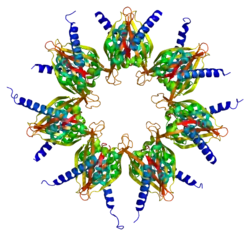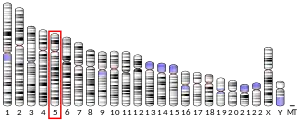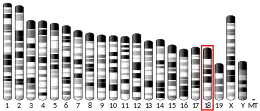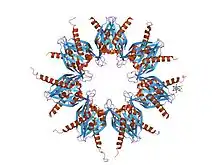Calcium/calmodulin-dependent protein kinase type II subunit alpha
Calcium/calmodulin-dependent protein kinase type II subunit alpha (CAMKIIα), a.k.a. Ca2+/calmodulin-dependent protein kinase II alpha, is one subunit of CamKII, a protein kinase (i.e., an enzyme which phosphorylates proteins) that in humans is encoded by the CAMK2A gene.[5][6]
Function
The product of the CAMK2A gene is an enzyme that belongs to the serine/threonine-specific protein kinase family, as well as the Ca2+/calmodulin-dependent protein kinase II subfamily. Ca2+ signaling is crucial for several aspects of synaptic plasticity at glutamatergic synapses. This enzyme is composed of four different chains: alpha, beta, gamma, and delta. The alpha chain encoded by this gene is required for hippocampal long-term potentiation (LTP) and spatial learning. In addition to its calcium-calmodulin (CaM)-dependent activity, this protein can undergo autophosphorylation, resulting in CaM-independent activity. Two transcript variants encoding distinct isoforms have been identified for this gene.[7]
References
- GRCh38: Ensembl release 89: ENSG00000070808 - Ensembl, May 2017
- GRCm38: Ensembl release 89: ENSMUSG00000024617 - Ensembl, May 2017
- "Human PubMed Reference:". National Center for Biotechnology Information, U.S. National Library of Medicine.
- "Mouse PubMed Reference:". National Center for Biotechnology Information, U.S. National Library of Medicine.
- Nagase T, Ishikawa K, Suyama M, Kikuno R, Hirosawa M, Miyajima N, Tanaka A, Kotani H, Nomura N, Ohara O (Jul 1999). "Prediction of the coding sequences of unidentified human genes. XIII. The complete sequences of 100 new cDNA clones from brain which code for large proteins in vitro". DNA Res. 6 (1): 63–70. doi:10.1093/dnares/6.1.63. PMID 10231032.
- Lin CR, Kapiloff MS, Durgerian S, Tatemoto K, Russo AF, Hanson P, Schulman H, Rosenfeld MG (Sep 1987). "Molecular cloning of a brain-specific calcium/calmodulin-dependent protein kinase". Proc Natl Acad Sci U S A. 84 (16): 5962–6. doi:10.1073/pnas.84.16.5962. PMC 298983. PMID 3475713.
- "Entrez Gene: CAMK2A calcium/calmodulin-dependent protein kinase (CaM kinase) II alpha".
- Walikonis RS, Oguni A, Khorosheva EM, Jeng CJ, Asuncion FJ, Kennedy MB (Jan 2001). "Densin-180 forms a ternary complex with the (alpha)-subunit of Ca2+/calmodulin-dependent protein kinase II and (alpha)-actinin". J. Neurosci. 21 (2): 423–33. doi:10.1523/JNEUROSCI.21-02-00423.2001. PMC 6763799. PMID 11160423.
- Dhavan R, Greer PL, Morabito MA, Orlando LR, Tsai LH (Sep 2002). "The cyclin-dependent kinase 5 activators p35 and p39 interact with the alpha-subunit of Ca2+/calmodulin-dependent protein kinase II and alpha-actinin-1 in a calcium-dependent manner". J. Neurosci. 22 (18): 7879–91. doi:10.1523/JNEUROSCI.22-18-07879.2002. PMC 6758084. PMID 12223541.
- Gardoni F, Mauceri D, Fiorentini C, Bellone C, Missale C, Cattabeni F, Di Luca M (Nov 2003). "CaMKII-dependent phosphorylation regulates SAP97/NR2A interaction". J. Biol. Chem. 278 (45): 44745–52. doi:10.1074/jbc.M303576200. PMID 12933808. S2CID 19885326.
Further reading
- Soderling TR (2000). "CaM-kinases: modulators of synaptic plasticity". Curr. Opin. Neurobiol. 10 (3): 375–80. doi:10.1016/S0959-4388(00)00090-8. PMID 10851169. S2CID 31122499.
- Hook SS, Means AR (2001). "Ca(2+)/CaM-dependent kinases: from activation to function". Annu. Rev. Pharmacol. Toxicol. 41 (1): 471–505. doi:10.1146/annurev.pharmtox.41.1.471. PMID 11264466.
- Yamamoto H (2002). "[Molecular mechanisms of the intracellular localizations of Ca2+/calmodulin-dependent protein kinase II isoforms, and their physiological functions]". Tanpakushitsu Kakusan Koso. 47 (3): 241–7. PMID 11889801.
- Countaway JL, Nairn AC, Davis RJ (1992). "Mechanism of desensitization of the epidermal growth factor receptor protein-tyrosine kinase". J. Biol. Chem. 267 (2): 1129–40. doi:10.1016/S0021-9258(18)48406-2. PMID 1309762.
- Wegner M, Cao Z, Rosenfeld MG (1992). "Calcium-regulated phosphorylation within the leucine zipper of C/EBP beta". Science. 256 (5055): 370–3. doi:10.1126/science.256.5055.370. PMID 1314426. S2CID 34818876.
- Omary MB, Baxter GT, Chou CF, Riopel CL, Lin WY, Strulovici B (1992). "PKC epsilon-related kinase associates with and phosphorylates cytokeratin 8 and 18". J. Cell Biol. 117 (3): 583–93. doi:10.1083/jcb.117.3.583. PMC 2289443. PMID 1374067.
- Bredt DS, Ferris CD, Snyder SH (1992). "Nitric oxide synthase regulatory sites. Phosphorylation by cyclic AMP-dependent protein kinase, protein kinase C, and calcium/calmodulin protein kinase; identification of flavin and calmodulin binding sites". J. Biol. Chem. 267 (16): 10976–81. doi:10.1016/S0021-9258(19)49862-1. PMID 1375933.
- Tokui T, Yamauchi T, Yano T, Nishi Y, Kusagawa M, Yatani R, Inagaki M (1990). "Ca2(+)-calmodulin-dependent protein kinase II phosphorylates various types of non-epithelial intermediate filament proteins". Biochem. Biophys. Res. Commun. 169 (3): 896–904. doi:10.1016/0006-291X(90)91977-Z. PMID 2114109.
- Inagaki M, Gonda Y, Nishizawa K, Kitamura S, Sato C, Ando S, Tanabe K, Kikuchi K, Tsuiki S, Nishi Y (1990). "Phosphorylation sites linked to glial filament disassembly in vitro locate in a non-alpha-helical head domain". J. Biol. Chem. 265 (8): 4722–9. doi:10.1016/S0021-9258(19)39622-X. PMID 2155236.
- Ohta Y, Ohba T, Miyamoto E (1990). "Ca2+/calmodulin-dependent protein kinase II: localization in the interphase nucleus and the mitotic apparatus of mammalian cells". Proc. Natl. Acad. Sci. U.S.A. 87 (14): 5341–5. doi:10.1073/pnas.87.14.5341. PMC 54319. PMID 2164678.
- Lee RH, Brown BM, Lolley RN (1990). "Protein kinase A phosphorylates retinal phosducin on serine 73 in situ". J. Biol. Chem. 265 (26): 15860–6. PMID 2394752.
- Ku NO, Omary MB (1994). "Identification of the major physiologic phosphorylation site of human keratin 18: potential kinases and a role in filament reorganization". J. Cell Biol. 127 (1): 161–71. doi:10.1083/jcb.127.1.161. PMC 2120194. PMID 7523419.
- Drewes G, Trinczek B, Illenberger S, Biernat J, Schmitt-Ulms G, Meyer HE, Mandelkow EM, Mandelkow E (1995). "Microtubule-associated protein/microtubule affinity-regulating kinase (p110mark). A novel protein kinase that regulates tau-microtubule interactions and dynamic instability by phosphorylation at the Alzheimer-specific site serine 262". J. Biol. Chem. 270 (13): 7679–88. doi:10.1074/jbc.270.13.7679. PMID 7706316. S2CID 2039456.
- Tsujimura K, Tanaka J, Ando S, Matsuoka Y, Kusubata M, Sugiura H, Yamauchi T, Inagaki M (1995). "Identification of phosphorylation sites on glial fibrillary acidic protein for cdc2 kinase and Ca(2+)-calmodulin-dependent protein kinase II". J. Biochem. 116 (2): 426–34. doi:10.1093/oxfordjournals.jbchem.a124542. PMID 7822264.
- Toyofuku T, Curotto Kurzydlowski K, Narayanan N, MacLennan DH (1994). "Identification of Ser38 as the site in cardiac sarcoplasmic reticulum Ca(2+)-ATPase that is phosphorylated by Ca2+/calmodulin-dependent protein kinase". J. Biol. Chem. 269 (42): 26492–6. doi:10.1016/S0021-9258(18)47221-3. PMID 7929371.
- Rivera VM, Miranti CK, Misra RP, Ginty DD, Chen RH, Blenis J, Greenberg ME (1993). "A growth factor-induced kinase phosphorylates the serum response factor at a site that regulates its DNA-binding activity". Mol. Cell. Biol. 13 (10): 6260–73. doi:10.1128/mcb.13.10.6260. PMC 364685. PMID 8413226.
- Omkumar RV, Kiely MJ, Rosenstein AJ, Min KT, Kennedy MB (1997). "Identification of a phosphorylation site for calcium/calmodulindependent protein kinase II in the NR2B subunit of the N-methyl-D-aspartate receptor". J. Biol. Chem. 271 (49): 31670–8. doi:10.1074/jbc.271.49.31670. PMID 8940188. S2CID 8332020.
- Rotenberg A, Mayford M, Hawkins RD, Kandel ER, Muller RU (1997). "Mice expressing activated CaMKII lack low frequency LTP and do not form stable place cells in the CA1 region of the hippocampus". Cell. 87 (7): 1351–61. doi:10.1016/S0092-8674(00)81829-2. PMID 8980240. S2CID 16704390.
- Paudel HK (1997). "The regulatory Ser262 of microtubule-associated protein tau is phosphorylated by phosphorylase kinase". J. Biol. Chem. 272 (3): 1777–85. doi:10.1074/jbc.272.3.1777 (inactive 2021-01-14). PMID 8999860.CS1 maint: DOI inactive as of January 2021 (link)
External links
- Human CAMK2A genome location and CAMK2A gene details page in the UCSC Genome Browser.





